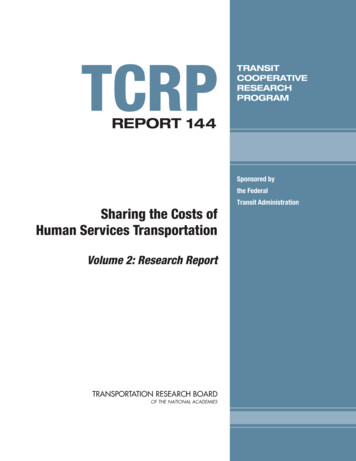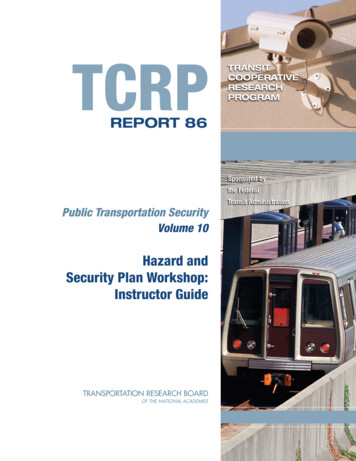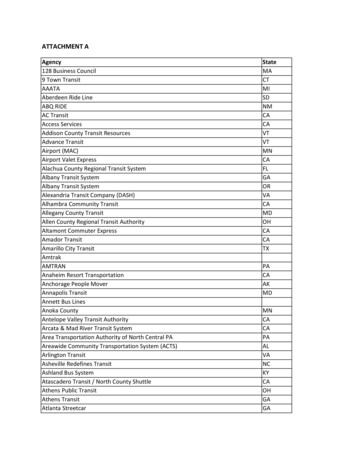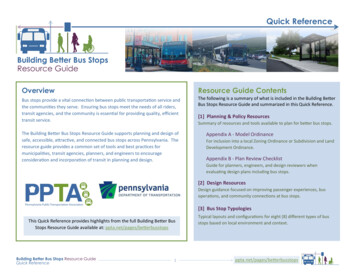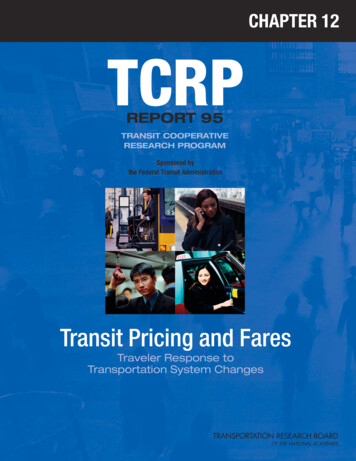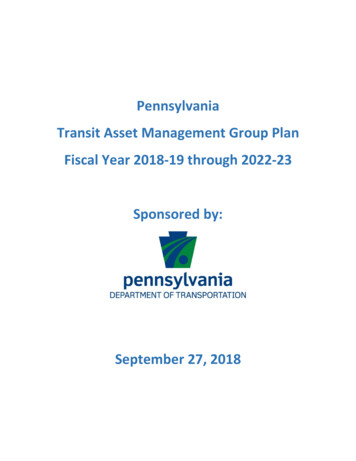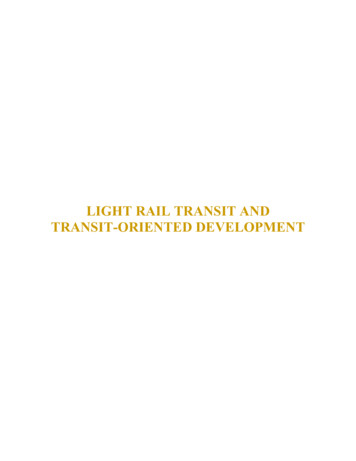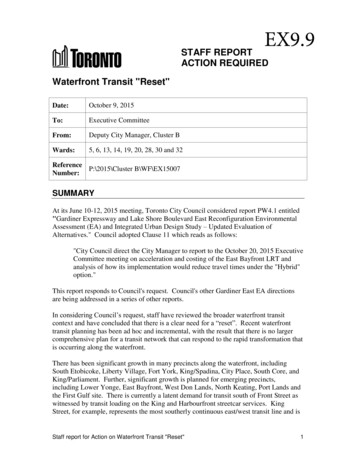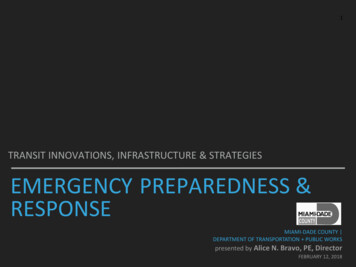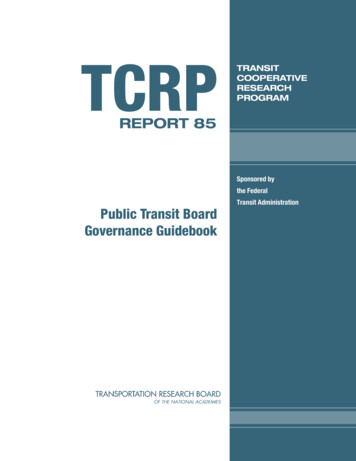
Transcription
TCRPTRANSITCOOPERATIVERESEARCHPROGRAMREPORT 85Sponsored bythe FederalTransit AdministrationPublic Transit BoardGovernance Guidebook
TCRP OVERSIGHT AND PROJECTSELECTION COMMITTEE(as of June 2002)TRANSPORTATION RESEARCH BOARD EXECUTIVE COMMITTEE 2002 (Membership as of September 2002)CHAIRLINDA S. WATSONCorpus Christi RTAChair: E. Dean Carlson, Secretary of Transportation, Kansas DOTVice Chair: Genevieve Giuliano, Professor, School of Policy, Planning, and Development, USC, Los AngelesExecutive Director: Robert E. Skinner, Jr., Transportation Research BoardMEMBERSDANNY ALVAREZMiami-Dade Transit AgencyKAREN ANTIONKaren Antion ConsultingGORDON AOYAGIMontgomery County GovernmentJEAN PAUL BAILLYUnion Internationale des Transports PublicsJ. BARRY BARKERTransit Authority of River CityRONALD L. BARNESCentral Ohio Transit AuthorityLINDA J. BOHLINGERHNTB Corp.ANDREW BONDS, JR.Parsons Transportation Group, Inc.JENNIFER L. DORNFTANATHANIEL P. FORD, SR.Metropolitan Atlanta RTACONSTANCE GARBERYork County Community Action Corp.FRED M. GILLIAMCapital Metropolitan Transportation AuthoritySHARON GREENESharon Greene & AssociatesKATHERINE M. HUNTER-ZAWORSKIOregon State UniversityROBERT H. IRWINBritish Columbia TransitJOYCE HOBSON JOHNSONNorth Carolina A&T State UniversityCELIA G. KUPERSMITHGolden Gate Bridge, Highway andTransportation DistrictPAUL J. LARROUSSENational Transit InstituteDAVID A. LEEConnecticut TransitCLARENCE W. MARSELLADenver Regional Transportation DistrictSTEPHANIE L. PINSONGilbert Tweed Associates, Inc.ROBERT H. PRINCE, JR.DMJM HARRISJEFFERY M. ROSENBERGAmalgamated Transit UnionRICHARD J. SIMONETTApbConsultPAUL P. SKOUTELASPort Authority of Allegheny CountyPAUL A. TOLIVERKing County MetroMEMBERSEX OFFICIO MEMBERSWILLIAM W. MILLARAPTAMARY E. PETERSFHWAJOHN C. HORSLEYAASHTOROBERT E. SKINNER, JR.TRBTDC EXECUTIVE DIRECTORLOUIS F. SANDERSAPTASECRETARYROBERT J. REILLYTRBOFFICERSWILLIAM D. ANKNER, Director, Rhode Island DOTTHOMAS F. BARRY, JR., Secretary of Transportation, Florida DOTMICHAEL W. BEHRENS, Executive Director, Texas DOTJACK E. BUFFINGTON, Associate Director and Research Professor, Mack-Blackwell National RuralTransportation Study Center, University of ArkansasSARAH C. CAMPBELL, President, TransManagement, Inc., Washington, DCJOANNE F. CASEY, President, Intermodal Association of North AmericaJAMES C. CODELL III, Secretary, Kentucky Transportation CabinetJOHN L. CRAIG, Director, Nebraska Department of RoadsROBERT A. FROSCH, Sr. Research Fellow, John F. Kennedy School of Government, Harvard UniversitySUSAN HANSON, Landry University Prof. of Geography, Graduate School of Geography, Clark UniversityLESTER A. HOEL, L. A. Lacy Distinguished Professor, Depart. of Civil Engineering, University of VirginiaRONALD F. KIRBY, Director of Transportation Planning, Metropolitan Washington Council of GovernmentsH. THOMAS KORNEGAY, Exec. Dir., Port of Houston AuthorityBRADLEY L. MALLORY, Secretary of Transportation, Pennsylvania DOTMICHAEL D. MEYER, Professor, School of Civil and Environmental Engineering, Georgia Institute ofTechnologyJEFF P. MORALES, Director of Transportation, California DOTDAVID PLAVIN, President, Airports Council International, Washington, DCJOHN REBENSDORF, Vice Pres., Network and Service Planning, Union Pacific Railroad Co., Omaha, NECATHERINE L. ROSS, Executive Director, Georgia Regional Transportation AgencyJOHN M. SAMUELS, Sr. Vice Pres.-Operations Planning & Support, Norfolk Southern Corporation,Norfolk, VAPAUL P. SKOUTELAS, CEO, Port Authority of Allegheny County, Pittsburgh, PAMICHAEL S. TOWNES, Exec. Dir., Transportation District Commission of Hampton Roads, Hampton, VAMARTIN WACHS, Director, Institute of Transportation Studies, University of California at BerkeleyMICHAEL W. WICKHAM, Chairman and CEO, Roadway Express, Inc., Akron, OHM. GORDON WOLMAN, Prof. of Geography and Environmental Engineering, The Johns Hopkins UniversityEX OFFICIO MEMBERSMIKE ACOTT, President, National Asphalt Pavement AssociationMARION C. BLAKEY, Federal Aviation Administrator, U.S.DOTREBECCA M. BREWSTER, President and CEO, American Transportation Research Institute, Atlanta, GAJOSEPH M. CLAPP, Federal Motor Carrier Safety Administrator, U.S.DOTTHOMAS H. COLLINS (Adm., U.S. Coast Guard), Commandant, U.S. Coast GuardJENNIFER L. DORN, Federal Transit Administrator, U.S.DOTELLEN G. ENGLEMAN, Research and Special Programs Administrator, U.S.DOTROBERT B. FLOWERS (Lt. Gen., U.S. Army), Chief of Engineers and Commander, U.S. Army Corps ofEngineersHAROLD K. FORSEN, Foreign Secretary, National Academy of EngineeringEDWARD R. HAMBERGER, President and CEO, Association of American RailroadsJOHN C. HORSLEY, Exec. Dir., American Association of State Highway and Transportation OfficialsMICHAEL P. JACKSON, Deputy Secretary of Transportation, U.S.DOTROBERT S. KIRK, Director, Office of Advanced Automotive Technologies, U.S. DOEWILLIAM W. MILLAR, President, American Public Transportation AssociationMARGO T. OGE, Director, Office of Transportation and Air Quality, U.S. EPAMARY E. PETERS, Federal Highway Administrator, U.S.DOTJEFFREY W. RUNGE, National Highway Traffic Safety Administrator, U.S.DOTJON A. RUTTER, Federal Railroad Administrator, U.S.DOTWILLIAM G. SCHUBERT, Maritime Administrator, U.S.DOTASHISH K. SEN, Director, Bureau of Transportation Statistics, U.S.DOTROBERT A. VENEZIA, Earth Sciences Applications Specialist, National Aeronautics and Space AdministrationTRANSIT COOPERATIVE RESEARCH PROGRAMTransportation Research Board Executive Committee Subcommittee for TCRPE. DEAN CARLSON, Kansas DOT (Chair)JENNIFER L. DORN, Federal Transit Administration, U.S.DOTGENEVIEVE GIULIANO, University of Southern California, Los AngelesLESTER A. HOEL, University of VirginiaWILLIAM W. MILLAR, American Public Transportation AssociationJOHN M. SAMUELS, Norfolk Southern Corporation, Norfolk, VAROBERT E. SKINNER, JR., Transportation Research BoardPAUL P. SKOUTELAS, Port Authority of Allegheny County, Pittsburgh, PAMICHAEL S. TOWNES, Transportation District Commission of Hampton Roads, Hampton, VA
TRANSIT COOPERATIVE RESEARCH PROGRAMTCRPREPORT 85Public Transit BoardGovernance GuidebookSIMON & SIMON RESEARCHANDASSOCIATES, INC.Elkridge, MDIN CONJUNCTION WITHWILL SCOTT & ASSOCIATES, LLCCincinnati, OHPRANGLEY & COMPANYCincinnati, OHGROUP DIMENSIONSBarrington, RIS UBJECT A REASPublic TransitResearch Sponsored by the Federal Transit Administration in Cooperation with the Transit Development CorporationTRANSPORTATION RESEARCH BOARDWASHINGTON, D.C.2002www.TRB.org
TRANSIT COOPERATIVE RESEARCH PROGRAMTCRP REPORT 85The nation’s growth and the need to meet mobility,environmental, and energy objectives place demands on publictransit systems. Current systems, some of which are old and in needof upgrading, must expand service area, increase service frequency,and improve efficiency to serve these demands. Research isnecessary to solve operating problems, to adapt appropriate newtechnologies from other industries, and to introduce innovations intothe transit industry. The Transit Cooperative Research Program(TCRP) serves as one of the principal means by which the transitindustry can develop innovative near-term solutions to meetdemands placed on it.The need for TCRP was originally identified in TRB SpecialReport 213—Research for Public Transit: New Directions,published in 1987 and based on a study sponsored by the Urban MassTransportation Administration—now the Federal Transit Administration (FTA). A report by the American Public TransportationAssociation (APTA), Transportation 2000, also recognized the needfor local, problem-solving research. TCRP, modeled after thelongstanding and successful National Cooperative HighwayResearch Program, undertakes research and other technical activitiesin response to the needs of transit service providers. The scope ofTCRP includes a variety of transit research fields including planning, service configuration, equipment, facilities, operations, humanresources, maintenance, policy, and administrative practices.TCRP was established under FTA sponsorship in July 1992.Proposed by the U.S. Department of Transportation, TCRP wasauthorized as part of the Intermodal Surface TransportationEfficiency Act of 1991 (ISTEA). On May 13, 1992, a memorandumagreement outlining TCRP operating procedures was executed bythe three cooperating organizations: FTA, the National Academies,acting through the Transportation Research Board (TRB); andthe Transit Development Corporation, Inc. (TDC), a nonprofiteducational and research organization established by APTA.TDC is responsible for forming the independent governing board,designated as the TCRP Oversight and Project Selection (TOPS)Committee.Research problem statements for TCRP are solicited periodicallybut may be submitted to TRB by anyone at any time. It is theresponsibility of the TOPS Committee to formulate the researchprogram by identifying the highest priority projects. As part of theevaluation, the TOPS Committee defines funding levels andexpected products.Once selected, each project is assigned to an expert panel,appointed by the Transportation Research Board. The panels prepareproject statements (requests for proposals), select contractors, andprovide technical guidance and counsel throughout the life of theproject. The process for developing research problem statements andselecting research agencies has been used by TRB in managingcooperative research programs since 1962. As in other TRB activities, TCRP project panels serve voluntarily without compensation.Because research cannot have the desired impact if products failto reach the intended audience, special emphasis is placed ondisseminating TCRP results to the intended end users of theresearch: transit agencies, service providers, and suppliers. TRBprovides a series of research reports, syntheses of transit practice,and other supporting material developed by TCRP research. APTAwill arrange for workshops, training aids, field visits, and otheractivities to ensure that results are implemented by urban and ruraltransit industry practitioners.The TCRP provides a forum where transit agencies cancooperatively address common operational problems. The TCRPresults support and complement other ongoing transit research andtraining programs.Project H-24 FY’2000ISSN 1073-4872ISBN 0-309-06768-5Library of Congress Control Number 2002112946 2002 Transportation Research BoardPrice 15.00NOTICEThe project that is the subject of this report was a part of the Transit CooperativeResearch Program conducted by the Transportation Research Board with theapproval of the Governing Board of the National Research Council. Suchapproval reflects the Governing Board’s judgment that the project concerned isappropriate with respect to both the purposes and resources of the NationalResearch Council.The members of the technical advisory panel selected to monitor this project andto review this report were chosen for recognized scholarly competence and withdue consideration for the balance of disciplines appropriate to the project. Theopinions and conclusions expressed or implied are those of the research agencythat performed the research, and while they have been accepted as appropriateby the technical panel, they are not necessarily those of the TransportationResearch Board, the National Research Council, the Transit DevelopmentCorporation, or the Federal Transit Administration of the U.S. Department ofTransportation.Each report is reviewed and accepted for publication by the technical panelaccording to procedures established and monitored by the TransportationResearch Board Executive Committee and the Governing Board of the NationalResearch Council.Special NoticeThe Transportation Research Board of the National Academies, the NationalResearch Council, the Transit Development Corporation, and the Federal TransitAdministration (sponsor of the Transit Cooperative Research Program) do notendorse products or manufacturers. Trade or manufacturers’ names appear hereinsolely because they are considered essential to the clarity and completeness of theproject reporting.Published reports of theTRANSIT COOPERATIVE RESEARCH PROGRAMare available from:Transportation Research BoardBusiness Office500 Fifth Street, NWWashington, DC 20001and can be ordered through the Internet rinted in the United States of America
The National Academy of Sciences is a private, nonprofit, self-perpetuating society of distinguished scholars engaged in scientific and engineering research, dedicated to the furtherance of science and technologyand to their use for the general welfare. On the authority of the charter granted to it by the Congress in1863, the Academy has a mandate that requires it to advise the federal government on scientific and technical matters. Dr. Bruce M. Alberts is president of the National Academy of Sciences.The National Academy of Engineering was established in 1964, under the charter of the National Academy of Sciences, as a parallel organization of outstanding engineers. It is autonomous in its administrationand in the selection of its members, sharing with the National Academy of Sciences the responsibility foradvising the federal government. The National Academy of Engineering also sponsors engineering programsaimed at meeting national needs, encourages education and research, and recognizes the superior achievements of engineers. Dr. William A. Wulf is president of the National Academy of Engineering.The Institute of Medicine was established in 1970 by the National Academy of Sciences to secure theservices of eminent members of appropriate professions in the examination of policy matters pertaining tothe health of the public. The Institute acts under the responsibility given to the National Academy ofSciences by its congressional charter to be an adviser to the federal government and, on its owninitiative, to identify issues of medical care, research, and education. Dr. Harvey V. Fineberg is presidentof the Institute of Medicine.The National Research Council was organized by the National Academy of Sciences in 1916 to associatethe broad community of science and technology with the Academy’s purposes of furthering knowledge andadvising the federal government. Functioning in accordance with general policies determined by the Academy, the Council has become the principal operating agency of both the National Academy of Sciences andthe National Academy of Engineering in providing services to the government, the public, and the scientificand engineering communities. The Council is administered jointly by both the Academies and the Instituteof Medicine. Dr. Bruce M. Alberts and Dr. William A. Wulf are chair and vice chair, respectively, of theNational Research Council.The Transportation Research Board is a division of the National Research Council, which serves theNational Academy of Sciences and the National Academy of Engineering. The Board’s mission is to promoteinnovation and progress in transportation by stimulating and conducting research, facilitating thedissemination of information, and encouraging the implementation of research results. The Board’s variedactivities annually engage more than 4,000 engineers, scientists, and other transportation researchers andpractitioners from the public and private sectors and academia, all of whom contribute their expertise in thepublic interest. The program is supported by state transportation departments, federal agencies includingthe component administrations of the U.S. Department of Transportation, and other organizations andindividuals interested in the development of transportation. www.TRB.orgwww.national-academies.org
COOPERATIVE RESEARCH PROGRAMS STAFFROBERT J. REILLY, Director, Cooperative Research ProgramsCHRISTOPHER W. JENKS, TCRP ManagerGWEN CHISHOLM-SMITH, Senior Program OfficerEILEEN P. DELANEY, Managing EditorPROJECT PANEL H-24Field of Policy and PlanningGEORGE F. DIXON, III, Greater Cleveland Regional Transit Authority (Chair)JOSEPH ALEXANDER, Parsons Corp., Washington, DCLORA GRAVES-MAYO, Washington Metropolitan Area Transit Authority (WMATA)NANCY K. JOHNSON, Dallas Area Rapid Transit, TXWADE LAWSON, South Jersey Transportation AuthorityPATRISHA PIRAS, AC Transit, San Lorenzo, CAJOE RIVERS, Chatham Area Transit Authority, Savannah, GAHOWARD SILVER, Golden Empire Transit District, Bakersfield, CAPAUL A. TOLIVER, Kings County (WA) MetroRICHARD P. STEINMANN, FTA Liaison RepresentativeTHOMAS S. URBAN, APTA Liaison RepresentativePETER SHAW, TRB Liaison RepresentativeAUTHOR ACKNOWLEDGMENTSThe research reported herein was performed under TCRP ProjectH-24 by SIMON & SIMON Research and Associates, Incorporated.This document was based on research performed in conjunctionwith Will Scott & Associates, LLC; Prangley & Company; andGroup Dimensions. SIMON & SIMON Research and Associates,Incorporated was the contractor for this study.Rosalyn M. Simon was the principal investigator. Research teammembers include Monica Simon of SIMON & SIMON; Will Scottand Jackie Davison of Will Scott & Assoc.; Bob Prangley and SteveDelgiudice of Prangley & Co.; and Janet Billson and Norman London of Group Dimensions.
FOREWORDBy Gwen ChisholmStaff OfficerTransportation ResearchBoardTCRP REPORT 85: Public Transit Board Governance Guidebook is a referencetool that provides information on the organization and composition of transit boards.The Guidebook describes the structure and practices of transit boards and includesinformation on board-selection methods, board size, board length of service, and boardcomposition. The Guidebook also includes a section on the primary role and activitiesof the transit board and the role of the transit board chair. There are guidelines fordetermining the roles and responsibilities of board members and a description of thecharacteristics of an effective board. The Guidebook may be used by policymakers,general managers, legal advisors, and board support personnel.The companion document to the Guidebook is a report, Public Transit System Policy Boards, that focuses on the findings of the research. A literature review was completed to identify characteristics of governance boards in the public transit industry. Anational survey was conducted to identify the characteristics and effectiveness of public transit boards. Five focus groups and six case studies were conducted to discuss transit board effectiveness and the operation of transit boards. This report is published asTCRP Web Document 21, available at: www4.trb.org/trb/crp.nsf.The organization and characteristics of a transit board directly affect how efficiently and effectively a board discharges its role and responsibilities. An understanding of how other transit boards work in terms of size, structure, and duties will help allboards understand what might work best for them and give them examples with whichto compare their present structure and composition. In short, better information isneeded on today’s transit boards. As policy decisions in transit become more complex,the role of a transit board becomes more critical. The Guidebook is designed to provideguidance to transit board members, general managers and appointing bodies withrespect to board powers, role, responsibilities, size structure, organization, and composition.SIMON & SIMON Research and Associates, Inc. in conjunction with Will Scott& Associates, LLC; Prangley & Company; and Group Dimensions conducted theresearch for TCRP Project H-24. To achieve the project’s objective developing a public transit board governance reference document, a comprehensive literature reviewwas undertaken to identify information on board powers, board role, board responsibilities, board size, board structure, board organization, and board composition. Anational survey of large, medium, and small public transit agencies was conducted toobtain information on transit board characteristics. Also, five focus groups with boardmembers and board member support staff and six in-depth case studies were performed. On the basis of the information gathered, the research team developed theGuidebook.
CONTENTS1ABOUT THIS GUIDE2CHAPTER 1The Need3CHAPTER 2Introduction5CHAPTER 3Organization and Composition of Transit Boards8CHAPTER 4Structure and Practices of Transit Boards11CHAPTER 5Transit Board Roles and Responsibilities15CHAPTER 6Transit Board Effectiveness20CASE STUDIES30REFERENCES
1PUBLIC TRANSIT BOARDGOVERNANCE GUIDEBOOKABOUT THIS GUIDEThe Public Transit Board Governance Guidebook is a reference tool of public transit board governance practices used by small, medium, and large transit agencies indiverse geographic locations. This guidebook was developed as part of the TCRP Project H-24, “Public Transit System Policy Boards: Organization and Characteristics.”The project’s goal was to provide national data and information on public transit boardgovernance and the nature and characteristics of transit board effectiveness. The advicepresented in this guidebook is based on the results of a national survey of transit chiefexecutive officers/general managers and board chairs, a series of focus groups withtransit board members and support staff, and case studies of six selected transit systemboards.The guide is divided into six chapters.Chapter 1 describes the background on TCRP Project H-24 and this guidebook.Chapter 2 introduces the organization of the guidebook.Chapter 3 provides information on the organization and composition of transitboards. This section provides information on board selection methods, board size, andboard length of service, board composition, board member diversity, and reasons forboard service.Chapter 4 describes the structure and practices of transit boards. This sectionprovides information on new board member orientation, board meetings, committeestructure, compensation, and board administrative support. This section also includesguidelines for the structure and governance of committees.Chapter 5 describes the core areas of transit board roles and duties. This section provides information on the primary role and activities of the board and the role of theboard chair. The section also includes recommended guidelines for determining theroles and responsibilities of board members and a sample transit board member jobdescription.Chapter 6 describes the characteristics of an effective board and offers suggestionsfor improving board effectiveness.The case studies provide additional insight on transit board operation.
2CHAPTER 1THE NEEDBOARD GOVERNANCEBoard governance is a prominent part of public administration. On the basis of the theory that a group of citizensappointed or elected for a specified period of time can bestrepresent the public interest, policy boards are an importantpart of public-sector activities. Although widely accepted atevery level of government, little empirical information existson the organization and characteristics of public policy governance boards. Governance boards are usually created as partof legislation establishing a public organization, but becausethere is no model legislation, board organization and characteristics vary greatly. A board of directors usually governspublic transit systems, but even less information is availableabout the characteristics and structure of public transit boards.For the most part, the information available is extrapolatedfrom the practices of private-sector and private, non-profitgovernance boards.Public transit boards vary in terms of characteristics, selection methods, duties, roles, and powers. The collaboration oftransit general managers/executive officers and board members is vital to the effectiveness of transit agencies, but becauseso little is written about how they operate, there is often misunderstanding about the critical role of the board and partic-ularly how it differs from management. The roles of boardgovernance and management are often blurred and the distinction between oversight and interference is unclear. Limited, if any, information is available to public transit executivesand board members seeking such a clarification. Similarly,there is a dearth of information to define and describe transitboard effectiveness. Such information is needed to assessboard performance and to assist transit executives who desireto consolidate or change the structure of their boards toimprove their effectiveness.This study was intended to provide national data and information on public transit board governance and the nature andcharacteristics of transit board effectiveness. To achieve thestudy’s objectives, three methods of data collection were used:1. National survey of transit agency general managers/chief executive officers (CEOs) and board chairs,2. Focus groups with transit board members on transitboard and support staff effectiveness, and3. Case studies of six selected public transit boards.The results of this research were used to develop this reference document, which is designed to provide guidance ontransit board governance.
3CHAPTER 2INTRODUCTIONThe Public Transit Board Governance Guidebook is a reference tool of public transit board governance practices usedby small, medium and large transit agencies in diverse geographic locations. This guidebook was developed as part of theTCRP Project H-24, “Public Transit System Policy Boards:Organization and Characteristics.” The goal was to providenational data and information on public transit board governance and the nature and characteristics of transit boardeffectiveness.representing a response of rate of 53 percent. Board chairsreturned 77 surveys, representing a response rate of 44 percent. Collectively these surveys yielded information on 213transit systems (see Figure 1).The survey response represents a 50-percent return rate ofthe surveys distributed and 52 percent of the public transitsystems that are APTA members. These systems range in sizefrom those serving populations of over 1 million to areas withpopulations less than 50,000.RESEARCH METHODOLOGYTransit Board Focus GroupsTo achieve the study’s objectives, three methods of datacollection were used:Five focus groups on transit board effectiveness were heldwith transit board members and board support staff duringthe APTA Transit Board Seminar in Denver, Colorado, inJuly 2001. A total of 83 individuals—45 transit board members, and 38 board support staff—participated in the focusgroups.1. National survey of transit CEOs/general managers andboard chairs,2. Focus groups with transit board members on transitboard and support staff effectiveness, and3. Case studies of six selected public transit boards.Case StudiesNational SurveyA national survey of transit CEOs and board chairpersonswas conducted to identify board powers, role, responsibilities, size, structure, organization, composition, and perceptions of board effectiveness.The survey was administered to the entire population ofU.S. public transit systems that are members of the American Public Transit Association (APTA), as listed in the 2000edition of the APTA Directory. Outreach to the CommunityTransportation Association of America (CTAA) yielded anadditional listing of small, rural transit systems. A total of334 surveys were sent to transit CEOs/general managers; 175were sent to transit board chairs. (New board chairs hadreplaced 29 percent of the chairpersons as listed in the directory, and, in the transition, many surveys were not forwarded).A total of 177 responses were received from transit CEOs,Six case studies were conducted at the following transitsystems to provide additional insight on the operation of transit boards: Downeast Transportation, Inc., Ellsworth, Maine;Fort Worth Transportation Authority, Ft. Worth, Texas;Kenosha Transit, Kenosha, Wisconsin;Regional Transit District, Denver, Colorado;Salem Area Mass Transit District, Salem, Oregon; andSoutheastern Pennsylvania Transit Authority (SEPTA),Philadelphia, Pennsylvania.The advice presented in this guidebook is based on theresults of the research conducted. Key findings from thenational survey, focus groups, and cases studies are incorporated throughout this guidebook. In addition, the cases studies are included in their entirety.
4SURVEY RESPONSE RATETransit CEO'sBoard ChairsTotal Mailed/E-Mailed0Figure 1.Survey response rate.50100150200250300
5CHAPTER 3ORGANIZATION AND COMPOSITION OF TRANSIT BOARDSGovernance boards are usually created as part of legislation establishing a public organization to provide counsel andbalance to the management team. The legislation or subsequent bylaws set forth the method for member selection,terms of office, board size and composition, compensation,and general responsibilities of the members. In some instances,no governance board is required.The use of public transit policy boards dates back to thepassage of the Urban Mass Transit Act of 1964. A shift fromprivate ownership to public governance became the paradigmfor public transportation when states and regions enactedlegislation to establish transit authorities or transit districts.Transit boards became the legal governing bodies of thesenewly formed public transit systems. With the existing diversity in transit size, type, geographic location, and so on, thelegislation leaves the organization and characteristics of theboard to each system. As a result, public transit boards andtheir specific characteristics vary from system to system.some instances, a two-step process is used that requires anomination of a prospective board member by the chief executive and confirmation by the local or state legislative body.Appointment By Non-Elected Officials BoardNon-elected officials, such as a county transportationagency, appoint citizen representatives to the board.Joint Powers AuthoritiesJoint powers authorities (JPAs) are regional boards whereelected officials appoint m
ning, service configuration, equipment, facilities, operations, human resources, maintenance, policy, and administrative practices. TCRP was established under FTA sponsorship in July 1992. Proposed by the U.S. Department of Transportation, TCRP was authorized as part of the Intermodal Surface Transportation Efficiency Act of 1991 (ISTEA).
